Two of the most defining mediums of digital marketing are SEO and PPC. While SEO focuses on driving traffic to your site organically, PPC is fueled by buying paid advertisements that point to your brand. But both hinge on the proper composition of CRO (Conversion Rate Optimization) to make them sing.
CRO marketing aims to boost your website’s effectiveness by turning more visitors into customers. It’s essential for driving revenue and improving user experience. If you’re seeking ways to improve your CRO approach (or learn more about it in general), then you’ve come to the right place.
We’re about to dive deep into what CRO marketing is, why it’s crucial to practically every aspect of digital marketing, and the strategies and tools you can use to master it.
TABLE OF CONTENTS:
Understanding CRO Marketing
Conversion rate optimization (CRO) is all about enhancing your website to increase the percentage of users who perform a desired action, be it making a purchase, filling out a form, or clicking that ‘add to cart’ button.
Where SEO is focused on making your site more easily discoverable on search engines, CRO is all about making your offer more discoverable and appealing on your website. It relies on orchestrating the perfect balance of messaging, page layout, and logical sales flow (following the buyer’s journey) to drive desirable actions from your site visitors.
The premise is fairly straightforward: identify the desired action you want your users to take — known as conversion goals — and then optimize your site to encourage those actions using conversion rate optimization strategies.
Simple, right?
Well, that’s where things can get complicated. A lot of what goes into CRO involves testing the heck out of everything under the sun.
Conversion rate optimization is accomplished through a thorough analysis of user behavior, goal-setting, and the implementation of data-driven changes to enhance the site’s performance.
Calculating CRO
Calculating your average conversion rate involves dividing the number of conversions by the total number of visitors. So, if we had, say 50 conversions out of 450 visitors, the equation would look like this:
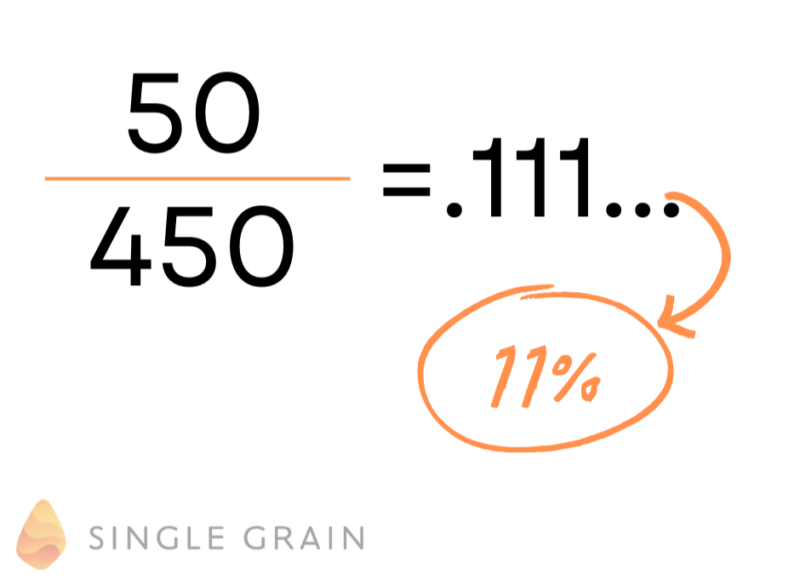
Wielding CRO marketing is just as vital for online business presence as SEO and paid media placements. It’s one thing to optimize your content such that it can get in front of your audience. It’s another thing entirely what you do with that audience once they’ve landed on your site.
Key Takeaway
Importance of CRO Marketing
At its heart, CRO marketing enhances the user experience, reduces acquisition costs, and boosts conversions. When done right, it can transform a website into a finely-tuned sales machine that:
- Meets customer needs and preferences with precision, ensuring that users find exactly what they’re looking for quickly and easily.
- Increases customer satisfaction by providing a seamless and enjoyable browsing experience, leading to higher retention rates.
- Improves brand reputation through consistent and positive interactions, fostering trust and loyalty among users.
- Maximizes revenue potential by optimizing every aspect of the user journey, turning more visitors into paying customers and increasing overall sales.
Personalized content recommendations, driven by CRO, can substantially enhance the user experience, making visitors feel valued and understood. Continuous testing and optimization ensure that the user experience of your landing pages evolves with user preferences and behaviors, making the site more engaging and effective over time.
Among the compelling reasons to invest in CRO, when given the proper attention, it can lead to lower customer acquisition costs. For example, doubling the conversion rate from 1% to 2% results in a doubling of leads and customers, effectively cutting the acquisition cost per lead or customer in half. By focusing on what drives conversions and optimizing various elements of the website, CRO marketing ultimately turns more visitors into customers, amplifying the site’s conversion rate effectiveness!
Key Takeaway
Key Elements of an Effective CRO Strategy
Boiled down, there are three fundamental elements that make up an effective conversion rate optimization strategy: conversion research, hypothesis creation, and A/B testing.
Each of these steps is crucial for understanding user behavior, determining what changes might increase conversions, and testing those changes to see what works best.
Conversion Research
Conversion research involves collecting and analyzing data from various sources to identify conversion bottlenecks and understand user behavior. This can include website analytics, customer feedback, and tools like heatmaps and session recordings.
Qualitative and quantitative research methods, such as polls, surveys, and interviews, are invaluable for gathering immediate customer feedback and gaining deeper insights into user behavior.
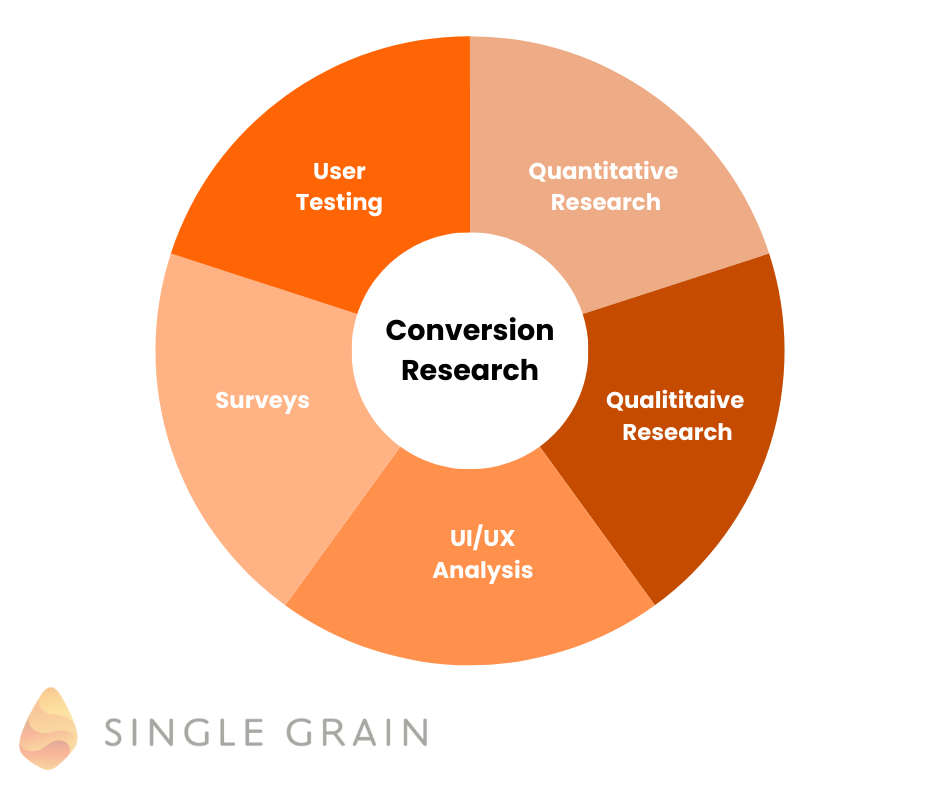
One of them most popular modes of collecting user surveys is by implementing Net Promoter Score tracking for your business, which can be mighty helpful in gauging overall satisfaction with your brand and its assets (like your website):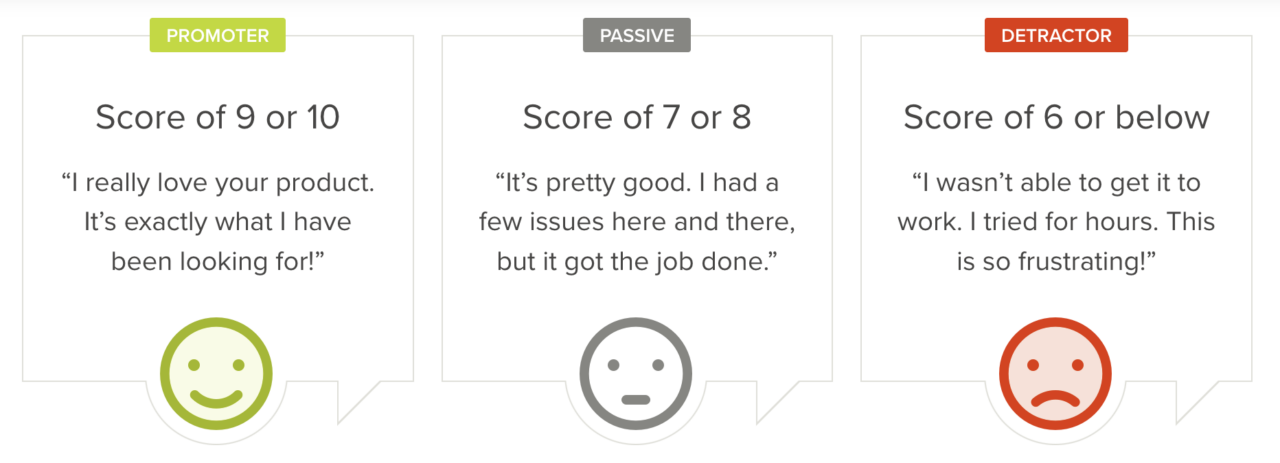
Complementing CRO test data with qualitative user testing is crucial for a comprehensive understanding of your visitors. Creating detailed customer personas can help paint a clearer picture of your target audience and their needs.
Once the data is gathered, the next step is to prioritize the uncovered conversion issues, focusing on the most impactful ones first. This entire approach gives numerical metrics context, leading to more informed optimization decisions.
Using tools like heatmaps and session recordings allows you to visualize where users click, scroll, and hover on your site, helping to identify barriers to conversions. The insights you can glean from this tracking method are critical for refining your website’s user interface and experience, ultimately encouraging more conversions.
We like to use CrazyEgg, but HotJar and LuckyOrange are also crowd favorites if you want to try out some heatmap software (we’ll cover more on heatmaps shortly).
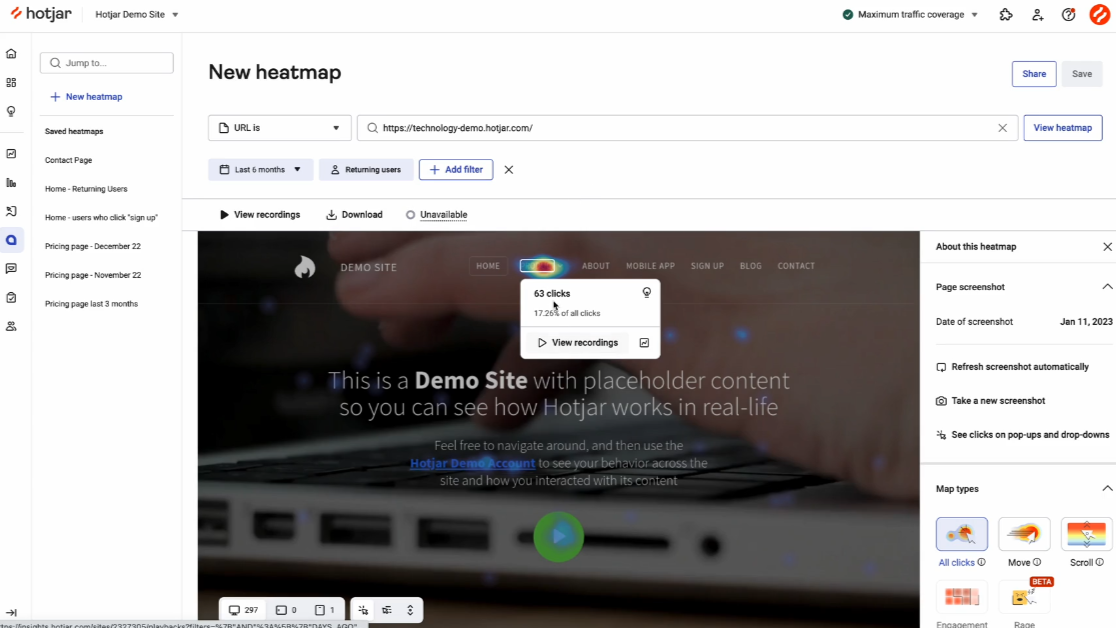
Hypothesis Creation
After collecting and examining your data, formulating hypotheses about potential changes that could enhance your conversion rates is the logical next step. These hypotheses should be based on your observations and data.
At Single Grain, we like to use the following hypothesis structure as a mental exercise when rationalizing conversion rate optimization:
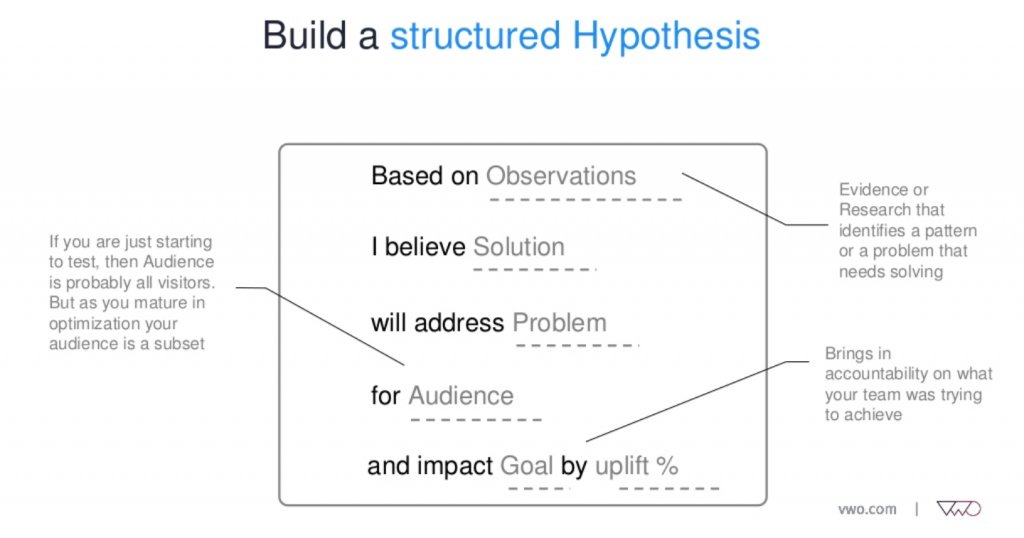
Prioritizing these hypotheses based on their potential impact and feasibility is crucial. For example, heatmaps might reveal that highlighting specific product features or sharing recent reviews could target users more precisely.
Test these hypotheses systematically and in isolation. That means testing one new thing with all other variables and factors remaining constant. In this way, you can determine which changes are making any impact.
A/B Testing
A/B testing is a cornerstone of CRO marketing, allowing you to compare different versions of your content to see which performs better. Start by identifying pages with high traffic but low conversion rates, as these have the most potential for improvement. By running controlled experiments, you can test variables like CTAs, subject lines, and body content to optimize performance:

For instance, AliveCor boosted its revenue by 27.39% through A/B testing different CTA designs and copy on its website. And you can do the same following a few of the A/B Testing practices they employed on their site:
- Creating variations of your web pages
- Delivering customized CTAs to different segments of your audience
- Comparing variant efficacy with the goal being to identify the best design and content features that resonate with your audience and drive conversions.
CRO experiments also inform the strategic positioning of elements like call-to-action buttons, ensuring they are prominent and accessible. If you continuously test and refine these elements, you can achieve significant uplifts in conversion rates and guarantee that your website is always performing at its best.
Key Takeaway
Setting and Achieving CRO Goals
The key to launching your CRO marketing strategy strongly is to establish the right goals. The first step is to identify critical metrics, also known as key performance indicators (KPIs), that define your overarching business goals. Clearly defining these KPIs is crucial for tracking and measuring your results effectively. If you don’t, any changes you make on your landing pages will be aimless.
For example, some specific and measurable conversion metrics you can focus on include:
- Increasing the click-through rate (CTR) on your call-to-action buttons
- Decreasing the bounce rate on your landing pages
- Improving the average time spent on your website
- Increasing the number of newsletter sign-ups
- Boosting the conversion rate on your checkout page
Identifying these goals allows you to gauge the success of your conversion rate optimization and make data-driven decisions to improve performance.
Defining Macro and Micro Goals
Macro goals focus on primary conversions, such as sales, revenue, or requests for quotes. These are the main objectives you want to achieve through your CRO efforts. On the other hand, micro goals are secondary actions that support your primary objectives, like email sign-ups, email clicks, or blog subscriptions. These intermediary steps are essential for guiding users toward your macro goals:

Clearly defining both macro and micro conversion goals, will help you create a more comprehensive and effective CRO strategy from:
A. The initial interaction
B. The user’s journey through your site
C. The checkout process
D. The final sale
Aligning with Business Objectives
Synchronizing your CRO goals with your overall business aims is important to ensure that your optimization initiatives contribute to your company’s wider objectives. When CRO goals are directly connected to business goals, it makes sure that the strategies are cohesive and support the company’s primary objectives. This congruency helps in generating revenue, enhancing customer experience, and creating more value for your existing customers.
For example, if your business goal is to increase revenue, your CRO efforts should focus on optimizing the customer journey to convert more visitors into paying customers.
If you align your CRO goals with your business objectives, you can be certain that your optimization efforts are driving meaningful results that support your company’s growth.
Key Takeaway
11 Tools for CRO Marketing
There’s a plethora of CRO marketing tools out there to enhance and simplify your CRO efforts, each catering to different facets of the optimization process.
These tools help with:
- Lead capture
- Research
- Analytics
- Running experiments to optimize conversion rates
We already touched on heatmap software like Hotjar, Crazy Egg and Lucky Orange. Here are some more to consider:
1) Optimizely
A powerful experimentation platform that supports A/B testing, multivariate testing, and multi-page funnel testing. Optimizely’s robust integration capabilities with third-party tools and real-time data processing are beneficial for larger enterprises.
2) VWO (Visual Website Optimizer)
Offers advanced A/B testing, multivariate testing, and behavioral targeting with an AI-powered copy generator. VWO’s visual editor and adaptable platform cater to both non-technical users and developers.
3) Unbounce
This landing page builder includes A/B testing and conversion intelligence tools, making it easy to create high-converting landing pages without coding. Its drag-and-drop editor is especially user-friendly.
4) Instapage
Provides landing page creation with heatmaps, A/B testing, and personalization features. Instapage is known for its fast-loading, mobile-responsive templates and comprehensive analytics.
5) Convert
A conversion optimization tool that emphasizes privacy compliance, Convert offers A/B testing, multivariate testing, and split testing with a strong focus on GDPR and CCPA compliance.
6) Kissmetrics
This customer analytics tool tracks individual and cohort behaviors, providing insights into user journeys and drop-off points. It’s particularly useful for SaaS companies and eCommerce businesses.

7) Heap
Automatically captures every user interaction, enabling detailed behavioral analysis without manual event tracking. Heap’s ease of integration with other platforms and automatic data collection is a major plus.
8) FullStory
This digital experience intelligence platform captures full-session recordings and provides real-time updates, helping identify points of friction in the user journey. FullStory is excellent for in-depth user behavior analysis.
9) AB Tasty
Provides a wide range of testing options, including A/B tests, split URL tests, and multivariate tests, with a focus on personalization and predictive testing. Its flexibility and user-friendly editor make it accessible for businesses of all sizes.
10) Mixpanel
Focuses on product and web analytics, enabling detailed funnel analysis and user segmentation. Mixpanel’s ability to track user interactions across web and mobile apps makes it ideal for SaaS platforms.
11) UserTesting
This tool gathers user feedback through videos of real users interacting with your site, offering valuable insights into user experiences and conversion barriers. It’s particularly useful for understanding customer perspectives.
Website Analytics Tools
Website analytics tools like Google Analytics are essential for understanding how users behave on your site. These tools offer insights into session duration, bounce rates, traffic sources, and user demographics, helping you gather behavioral insights from your existing website traffic. Google Analytics also allows for segmentation based on location, demographics, browsing history, and purchasing history, providing a comprehensive view of your audience.
Adobe Analytics is another powerful tool that tracks real-time multichannel analytical data across various sources, including websites, emails, and apps. It helps in examining user flow and monitoring conversion rates across different traffic sources. These insights are invaluable for refining your marketing strategies and improving your website’s performance.
User Behavior Analysis Tools
Understanding user behavior is crucial for effective CRO.
Continuing from earlier, heatmaps and session recorders give you an inside look at how visitors interact with your website. Heatmaps visualize where users click, scroll, and hover on a webpage, helping to identify the most and least engaging areas.
Apps like Crazy Egg and Hotjar offer heatmaps that collect visual data, evaluate user behavior, and analyze visitors’ experiences with forms.
Session recordings capture the user journey on your site, showing real-time interactions and identifying issues that might hinder conversions.
Tools like FullStory and Heap not only provide heatmaps and session recordings but also track in-depth metrics like page views and form submissions, offering a more complete view of user behavior.
Conversion Tracking Tools
Conversion tracking tools are essential for monitoring and measuring conversion rates effectively in conversion rate optimization marketing.
Optimizely, for example, allows running tests and experiments to refine customer interactions and improve conversions. This tool helps you understand which changes lead to better conversion rates and why.
FigPii is another helpful tool that enables you to:
- Identify who is converting and the reasons behind their conversions
- Offer valuable insights into user behavior
- Provide key information for optimizing conversion rates
- Make data-driven decisions that boost conversions and enhance overall website performance
Developing a CRO Marketing Strategy
Crafting a successful CRO strategy entails scrutinizing traffic sources, pinpointing conversion barriers, and refining conversion paths. Each of these steps is crucial for understanding where improvements can be made and how to implement them effectively.
Traffic Source Analysis
Analyzing traffic sources is essential for understanding where your website visitors are coming from and refining your marketing strategies to better reach your target audience. Investing in SEO and PPC advertising can drive targeted traffic to your site, increasing the chances of conversions. By filtering conversion data by key demographics like geographic region or social media traffic, you can tailor your funnels for different target audiences.
Using tools like Google Analytics, you can track where your traffic is coming from and how these site visitors interact with your site. This data helps you identify which sources are most effective at driving conversions and where you might need to adjust your marketing efforts.
Identifying Conversion Barriers
Identifying conversion barriers is a critical step in the CRO process. It’s important to understand why customers leave the website without converting and pinpoint areas for improvement. Analyzing the current conversion process helps identify where customers drop off and stop interacting with the business.
Google Analytics provides the capability to assess conversion leakage on forms. Additionally, it enables a deeper examination of conversion rates throughout the customer journey via micro funnel analysis, which is a part of the overall conversion funnel:
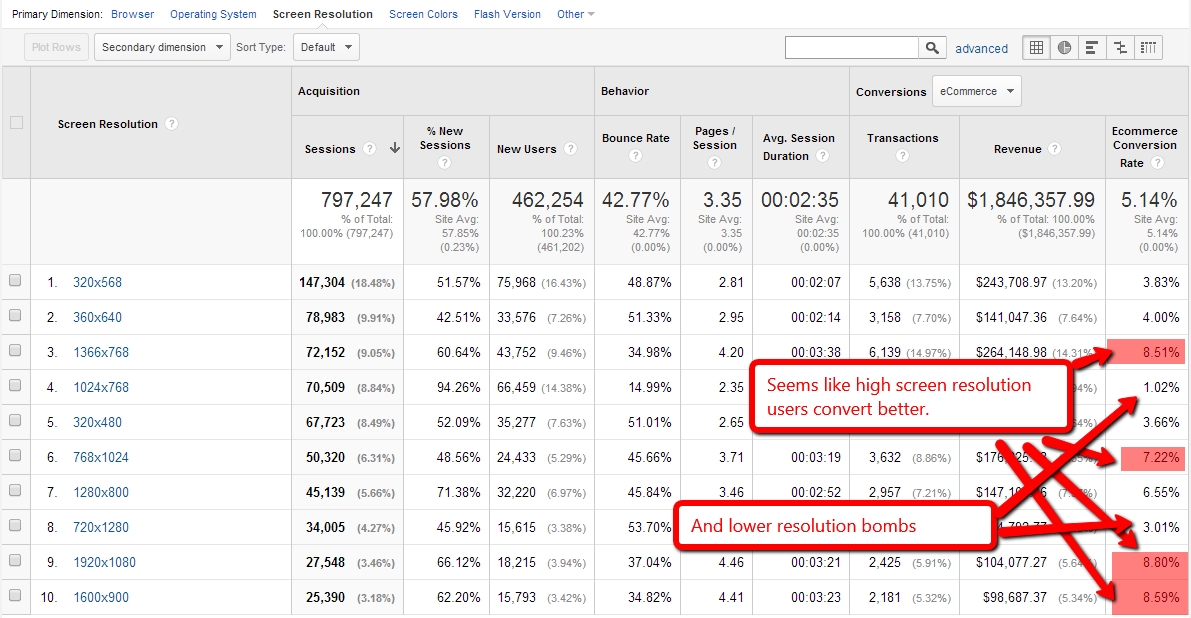
Feedback tools like Hotjar’s on-site surveys and feedback widgets provide valuable voice-of-the-customer feedback to identify pain points:
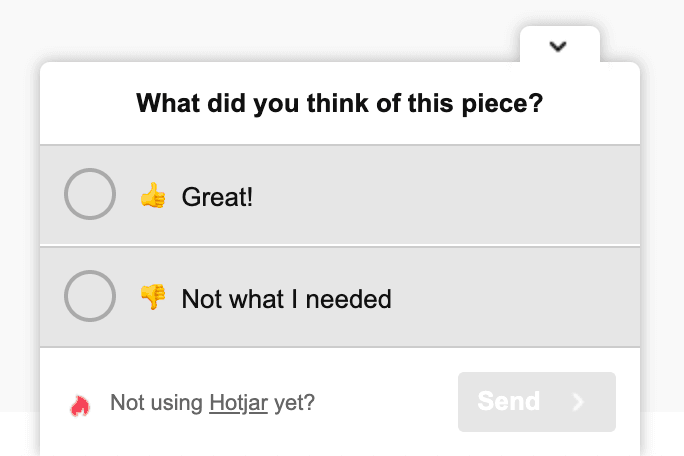
Additionally, FullStory’s session recordings can help in identifying barriers to user behavior on websites and mobile apps. By addressing these barriers, you can improve the user experience and increase conversion rates.
Optimizing Conversion Paths
Once you’ve identified the barriers to conversion, the next step is to optimize the conversion paths. Here are some strategies to consider:
- Create a compelling value proposition by understanding your target audiences and addressing their pain points.
- Tailor marketing messages and website content to be relevant and resonate with your target audiences.
- Streamline the conversion process on websites by reducing friction points to improve clarity and user experience.
- Implement shorter forms that ask for only the most essential information to increase conversion rates.
Utilizing scarcity tactics and exclusive deals can instill a sense of urgency in users, encouraging them to convert. For example, adding a progress indicator in the checkout process can help users understand how many steps are left, reducing abandonment and improving conversion paths.
Creating a visually appealing and responsive mobile website design is essential for forming positive first impressions and encouraging conversions.
Key Takeaway
Best Practices for CRO Marketing
Execution of best practices in CRO marketing can lead to substantial enhancements in conversion rates. While the total list of CRO best practices is constantly evolving, here is a quick list to get you started.
1) Reducing Page Load Speeds
Reducing webpage load time is another important best practice, especially for a landing page, as slow loading speeds can lead to high bounce rates and a poor user experience.
2) Contextual CTAs
Clear and compelling call-to-action (CTA) buttons help direct visitors toward desired actions without rushing them. Adding CTAs within the content, fixing SEO, and experimenting with different copy variations can also enhance conversions.
3) Simplified Navigation
Use simple and intuitive navigation menus to help users find what they are looking for quickly. The hamburger menu is particularly effective for mobile navigation.
4) Customer Testimonials
Displaying reviews and testimonials builds trust and improves conversion rates. Including trust signals like customer testimonials and industry badges can increase visitor-to-customer conversion rates. Personalized content and product recommendations based on user behavior can drive a lot more impact, making users feel valued and understood.
5) Offer “Free Trial” or “Freemium”
Offering a free trial or a freemium plan can increase engagement and conversions by reducing the initial commitment required from users. This approach can be particularly effective for SaaS products, allowing potential customers to experience the value of your product before making a purchase decision.
6) Clear Value Proposition
Clearly communicate the benefits and unique selling points of your product or service. A strong value proposition can persuade visitors to take the desired action and convert.
7) Mobile Optimization
Ensure your website is mobile-friendly, as a significant portion of web traffic comes from mobile devices. A responsive design improves the user experience and increases conversion rates on mobile devices.
8) Personalized User Experience
Tailor content and recommendations based on user behavior and preferences. Personalization can significantly enhance user engagement and conversion rates.
Key Takeaway
Case Studies of Successful CRO Implementations
Time to take a look at a few textbook examples of how a few concentrated CRO improvements helped move the needle substantially for some high-profile brands.
Netflix
Netflix, for instance, uses data-driven approaches like analyzing customer viewing patterns to personalize content recommendations. This strategy has helped Netflix improve user engagement and retention significantly.
Venture Harbour
Venture Harbour increased conversions by 743% on their inquiry forms by using multi-step forms instead of traditional single-step forms. This change made the process more user-friendly and reduced form abandonment rates:

DashThis
DashThis improved their free trial to paid user conversion rate by 50% by simplifying the setup process and adding tutorial guides. By making it easier for users to get started, DashThis enhanced their overall user experience and conversion rates.
World of Wonder
By introducing AI optimization tools, World of Wonder, the production company behind the hit TV show Rupaul’s Drag Race, tailored content dynamically based on visitor behavior and historical data. This automated method allowed for rapid A/B testing and content personalization, leading to a 19.7% increase in conversion rates across their landing pages, despite limited time and resources for manual optimization.
TruckersReport
TruckersReport generated 21.7% more opt-ins for job offers by creating a mobile-friendly landing page and revising the form headline and CTA. They addressed truck drivers’ needs for better pay, used a relatable photo, and changed the CTA to “start getting job offers,” along with adding social proof. These changes led to a significant improvement in conversion rates.

Learn More: You can read a more thorough breakdown of TruckersReport’s CRO case study as well as twelve more really solid case study examples over here.
Last Words on CRO Marketing
Mastering conversion optimization involves understanding its principles, recognizing its importance, and implementing key elements such as conversion research, hypothesis creation, and A/B testing.
Setting clear CRO marketing goals and aligning them with business objectives ensures cohesive strategies and measurable results. Utilizing the right tools for website analytics, user behavior analysis, and conversion tracking is essential for optimizing conversion rates.
Let’s quickly run through a high-level overview of what we just covered:
Final Takeaways
- Understanding and implementing Conversion Rate Optimization (CRO) is vital for businesses to convert more visitors into customers by analyzing user behavior, setting clear goals, and using data-driven changes.
- Key elements of an effective CRO strategy include thorough conversion research, hypothesis creation based on data, and A/B testing to determine the most effective changes for boosting conversion rates.
- Utilizing various CRO tools and best practices, such as website analytics, user behavior analysis, conversion tracking, and optimizing conversion paths, can significantly enhance user experiences, reduce acquisition costs, and improve conversion rates.
If you follow best practices, address common challenges, and take heed from successful case studies of other brands, you can significantly enhance your website’s performance in driving more conversions.
In the grand scheme, CRO is an ongoing process that requires constant testing, and analysis. With dedication and the right approach, you can unlock your website’s full potential and achieve off-the-charts results.
If you’re ready to start optimizing your conversion rate, Single Grain’s marketing experts can help!👇
Recommended Video
For more insights and lessons about marketing, check out our Marketing School podcast on YouTube.
Frequently Asked Questions
-
What is conversion rate optimization (CRO)?
Conversion rate optimization (CRO) is focused on increasing the percentage of users who complete a desired action on a website, like making a purchase or filling out a form.
-
Why is CRO important for my business?
CRO is important for your business because it improves user experience, lowers acquisition costs, and boosts conversions, leading to more customers.
-
What are some common CRO tools?
Some common CRO tools are website analytics tools like Google Analytics, user behavior analysis tools like Hotjar, and conversion tracking tools like Optimizely. These tools can help optimize your website for better conversions.
-
How do I set effective CRO goals?
To set effective CRO goals, make sure to establish clear and specific objectives that tie in with your business goals. Identify KPIs to monitor and assess your progress.
-
What are some common challenges in CRO, and how can I overcome them?
To overcome common challenges in CRO, invest in user research, incorporate trust signals on your site, and make sure an intuitive user experience. These steps can help address issues related to audience understanding, trust, and user experience.



